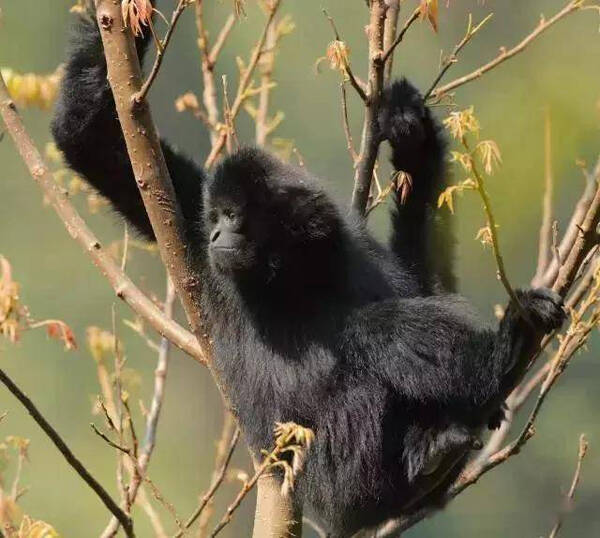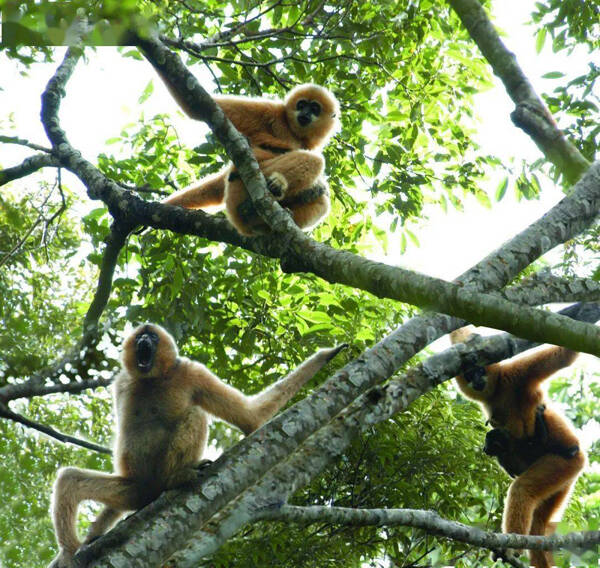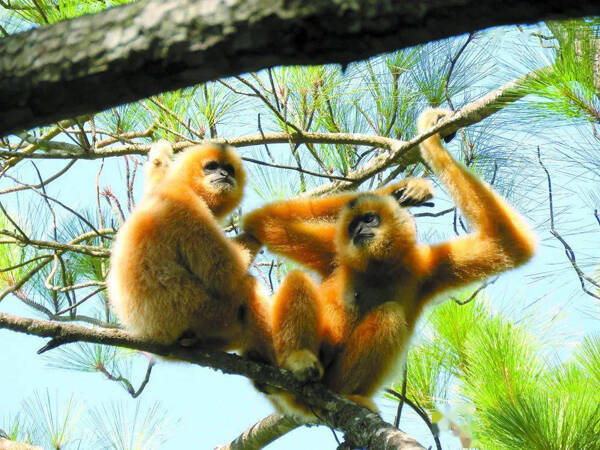Nomascus hainanus
IUCN
LCBasic Information
Scientific classification
- name:Nomascus hainanus
- Scientific Name:Nomascus hainanus,Hainan Gibbon、Hainan Black Crested Gibbon、Hainan Black Gibbon、Hainan Crested Gibbon,Hainan black-crested gibbon, bang-bang monkey, bao monkey
- Outline:Primates
- Family:Hylobates B.Gibbon
Vital signs
- length:40-50cm
- Weight:5.8-10kg
- lifetime:20-30years
Feature
One of the world's most endangered primates
Distribution and Habitat
Hainan gibbons are concentrated in the core area of the Bawangling National Nature Reserve on Hainan Island. Historically, Hainan gibbons were common on Hainan Island and were once widely distributed in Wuzhi Mountain, Yinggeling, Diaoluo Mountain, Limu Mountain, Dongfang and Baisha on Hainan Island. However, as of 2017, it is estimated that its entire geographical range is as low as 14-16 square kilometers in the Bawangling National Nature Reserve.
It mainly inhabits tropical rainforests and subtropical mountain wet monsoon evergreen broad-leaved forests. Its habitat altitude ranges from about 100-2500 meters. It prefers to live in lowland tropical rainforests below 600 meters above sea level. However, because the lowland rainforests were destroyed as early as the 20th century, the distribution of Hainan gibbons can only retreat to mountain rainforests between 650-1200 meters above sea level. It is the highest-altitude distribution species among the known gibbons.
Appearance
Hainan gibbons are medium-sized apes with a strong body, weighing 5.8-10 kg, 40-50 cm in length, and a binocular distance of 10.4-10.7 mm. The forelimbs are significantly longer than the hindlimbs, and the hindlimbs are 70.4% of the length of the forelimbs, slightly longer than other black-crested gibbons (Nomascus). They have no tail. Their fur is short and fluffy. Their chest and abdomen are light gray-yellow, often stained with dark brown. This species has a "black hat" on its head. Males and females are different in color. The male ape is black all over, slightly smaller than the female ape, with a short and upright crown-like tuft of hair on the top of its head, like angry hair; the female ape is golden all over, with gray-yellow, brown-yellow or orange-yellow on the back. As they age, some black hair will appear on their limbs, and there is a typical white face ring on their cheeks. Both males and females have a prismatic or polygonal black crown spot on their heads, ab
Details
Hainan Gibbon (scientific name: Nomascus hainanus) Foreign names: Hainan Gibbon, Hainan Black Crested Gibbon, Hainan Black Gibbon, Hainan Crested Gibbon, no subspecies.

The difference between Hainan gibbons and other gibbons is that its population is larger and it lives in a family-like manner. It usually lives in a family group of 3-5 to 7-8 heads, and sometimes there are even more than 10 heads in each group. The community's mating system is a "polygamous" system, that is, one adult male and two adult females. Only small groups that are disturbed are "monogamous". The activity range of the Hainan gibbon community is mostly around 60 hectares, which is much larger than other gibbons, and the population density is 2.6 per square kilometer. The activity area of Hainan gibbons is relatively fixed, and there is no seasonal migration. They are alert by nature, active at dawn and dusk, and have a fixed activity range and activity route. Hainan gibbons are arboreal apes, climbing trees freely, and their activities and foraging are carried out in the canopy or middle layer of 15-meter-high trees, rarely going down to small trees below 5 meters. It has no fixed sleeping place and does not make a nest. When sleeping, it curls up on the tree, and sometimes lies on the trunk with its back to the sky.
The daily activities of Hainan gibbons are very regular, and regular loud calls are an indispensable part of their day. Experts investigate the number of gibbons based on this habit. At 6 or 7 o'clock in the morning, before the sky is bright, the ape group begins to call for the first time. First, the male apes will cry loudly, followed by the female apes' noise and singing. The whole process takes 15 minutes. The sound is high and loud, and can be heard several kilometers away. It can be heard from miles away. This call can indicate that the ape group owns its territory and warns other ape groups not to invade. At the beginning, the big male ape will run to the high branches to "lead the singing" and make a long whistle-like call. Then the female apes and the little apes will join in, making short and chaotic "click, click" sounds. At this time, the two female apes in the ape group will be very excited and hug each other and jump non-stop. Two groups of gibbons not far apart sometimes call at the same time, as if they are competing to see who has the loudest voice and the best endurance. The calls, screams, and whistles in the forest are one after another, which is very lively and unforgettable. Afterwards, led by the male apes, the ape group forages in their own territory. At eight or nine o'clock, after eating and resting, they start calling for the second time. Then they patrol the territory while taking food. If the weather is good and there is enough food, the members of the ape group are in a good mood. The ape group will call again at noon. In the afternoon, they still eat while walking, but they will no longer call.

Hainan gibbons mainly feed on a variety of tropical wild fruits, young leaves, and flower buds, and occasionally eat insects, bird eggs and other animal foods. There are more than 100 types of food recorded for Hainan gibbons. They rarely go to the ground to drink water, and mainly drink dew from leaves. They also use their hands to scoop water from tree holes to drink. In the tropical rain forest of Bawangling, different wild fruits mature all year round, which can provide sufficient food for gibbons. However, Hainan gibbons have a special liking for sweet wild lychees. Bawangling is known as the hometown of wild lychees. Every ripe season, the tall wild lychee trees growing in the valleys are covered with fiery red fruits, which is spectacular. Gibbons, who like sweets like humans, will naturally not miss the opportunity. They often go to places with lower altitudes to enjoy this rare delicacy. However, wild lychees also have "big and small years". They usually bear fruit every few years, and it is not easy for gibbons to eat them once.
The Hainan gibbon has a polygynous mating system with two females and one male. Two females in the same social group may breed from the same male at the same time, which is a common mating system for Hainan gibbons. Females initiate mating by approaching the male and moving their heads and limbs in rhythmic, jerky movements. Multiple matings through dorsal-ventral contact may occur in a single day. Sexually active females occasionally engage in post-conception mating, which is relatively rare among primates. The birth interval is about 24 months, and one birth every 2-3 years. This time may be due to the fact that many popular food sources bear fruit every six months, thus linking reproduction with abundant food. The gestation period is 136-173 days, and one baby is born per litter. When male apes reach sexual maturity, they will be expelled from the ape group and live an independent life for a period of time. If they cannot win the position of leader in other ape groups, they are likely to be lonely for life. Male apes reach sexual maturity at the age of seven or eight. Females reach sexual maturity at the age of 9 and can live for more than 30 years.
Hainan black-crested gibbons have a strong dependence on their living environment and can only survive in the original monsoon forest. They cannot survive in artificial forests with a single forest species or in secondary forests that have been cut down. Hainan black-crested gibbons are accustomed to living on trees that are more than 15 meters high and have a breast diameter of more than 20 centimeters. The original tropical rainforests they like have five or six layers and rich food sources. In the selectively cut forests, gibbons face food shortages. Hainan black-crested gibbons mainly eat fruits of plants, including sycamore, kiwi, or Schefflera and Hainan holly leaves. If they are provided with enough food, they may be able to survive in secondary forests, but it is impossible in artificial forests. The scarcity of numbers naturally leads to inbreeding, resulting in the population being worse than the previous generation. Multiple diseases and no cure are also factors that make Hainan black-crested gibbons endangered. For example, postpartum wind, the average life span of Hainan black-crested gibbons in the natural environment is only about 20 years old. At the same time, the island distribution of the rainforest has also caused the Hainan black-crested gibbons to have a small population, discontinuous population distribution and low reproduction rate. In addition, the Hainan black-crested gibbons have a long generation cycle (7-8 years), etc., which has accelerated the extinction of Hainan black-crested gibbons.

Hainan black-crested gibbon is the most endangered primate. In early August 2002, the 19th International Primate Conference was held in Beijing. At the conference, 25 extremely endangered primates in the world were identified, and Hainan black-crested gibbon was ranked fifth. When determining the protection level of primates in China, Hainan black-crested gibbon was ranked first.
On August 21, 2020, after two days of discussion by top experts and scholars from multiple disciplines and fields around the world, the "Framework of the Hainan Gibbon Conservation Action Plan" was completed and released at the closing ceremony of the Hainan Gibbon Conservation International Symposium. The conservation goal of the Hainan gibbon is to establish a mechanism of unified planning, unified coordination, resource co-construction and sharing, and joint research. Relying mainly on natural recovery, supplemented by modern scientific and technological means, and under the premise of strengthening protection efforts and no major natural disasters, the Hainan gibbon population will be protected for healthy reproduction, and the Hainan gibbon population will double and grow sustainably in about 15 years, so that it can be quickly relieved from the critically endangered status. The Hainan Gibbon Conservation Action Plan includes: monitoring and database construction of Hainan gibbons and their habitats; conducting research on the nutritional ecology and reproductive biology of Hainan gibbons; conducting habitat restoration and optimization of Hainan gibbons; strengthening the coordination of Hainan gibbon protection and management; strengthening the popularization of Hainan gibbon protection; improving the economic development mode of communities around Hainan gibbon habitats and establishing a support system.
Listed in the 2015 ver3.1 of the World Conservation Union Red List of Threatened Species (IUCN) - Critically Endangered (CR).
Listed in Appendix I, Appendix II and Appendix III of the Convention on International Trade in Endangered Species of Wild Fauna and Flora (CITES) 2019 Edition Appendix I.
Listed in the first level of China's "National Key Protected Wildlife List" (February 5, 2021).
Listed in the list of priority protected species in the "Hainan Tropical Rainforest National Park" on April 23, 2022.
Protect wildlife and eliminate game.
Maintaining ecological balance is everyone's responsibility!








